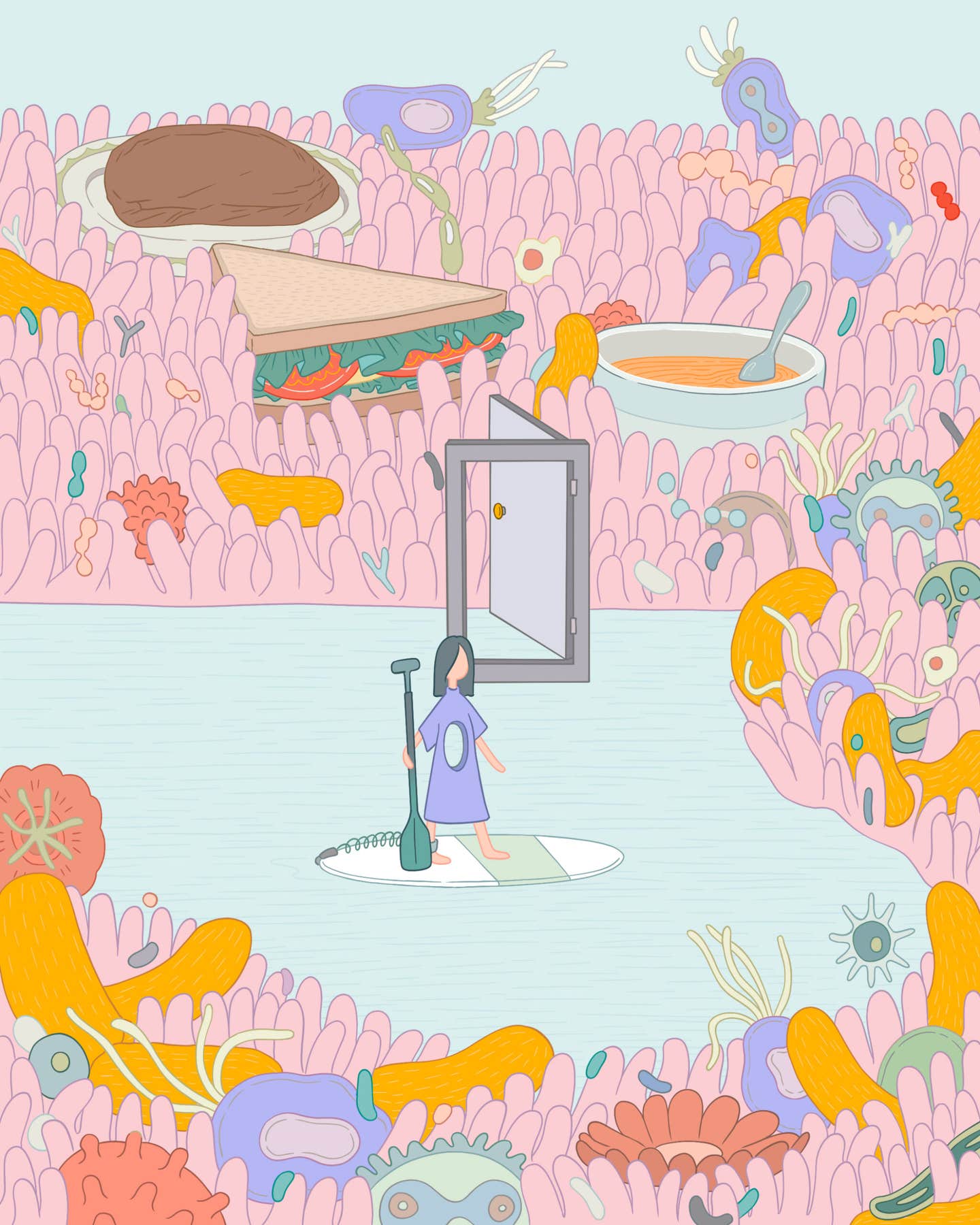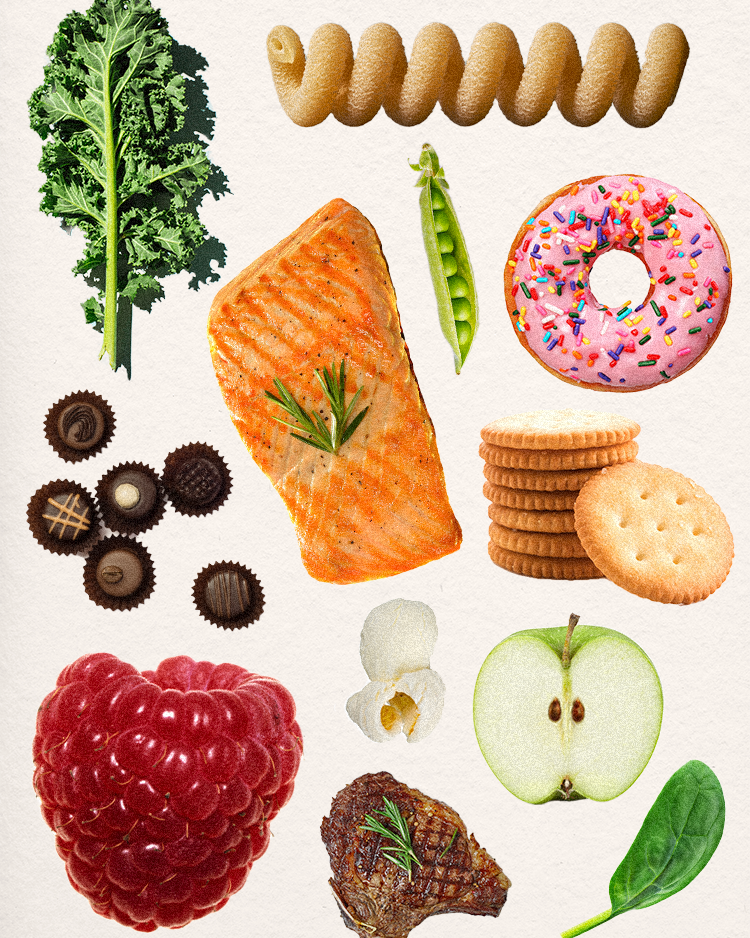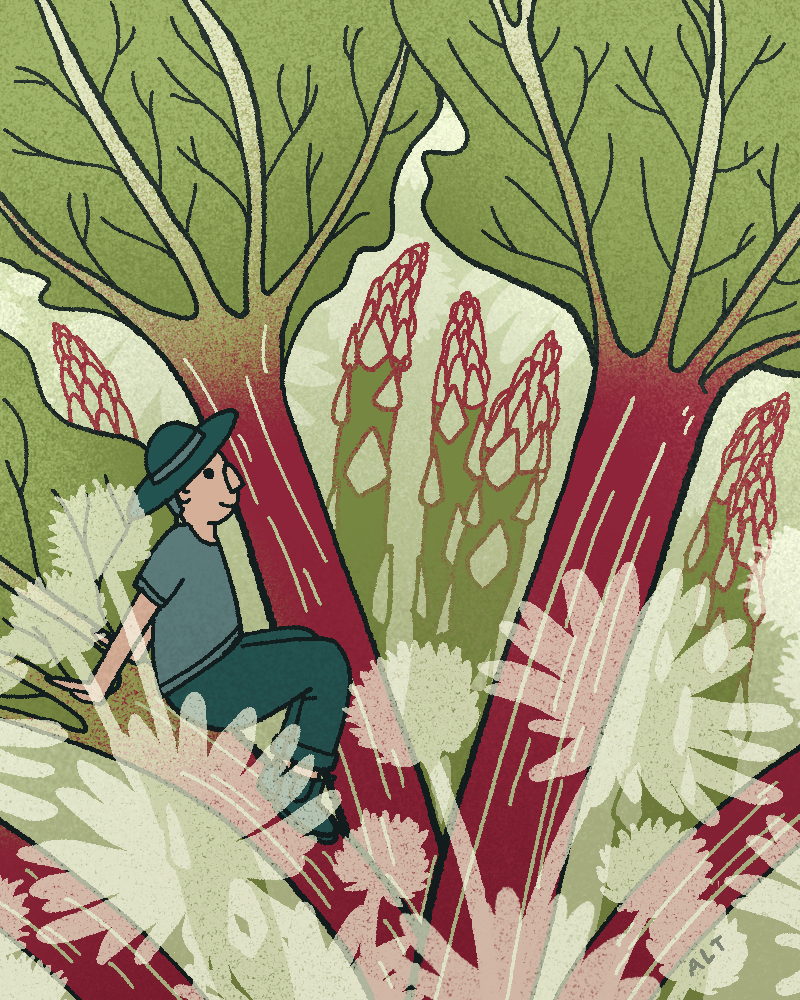Is Travel Actually Bad for Your Gut?
By taking a few simple precautions, you can cut down on discomfort and lower your risk of getting sick.

Welcome to Gut Check, our column dedicated to the complex, ever-evolving relationship between food and our bodies. Whether you’re curious about mindful eating or want to understand what makes picky eaters picky, read on and let award-winning journalist Betsy Andrews answer all your burning questions.
The last time I ever ate at one of my old, go-to lunch spots, a Manhattan restaurant favorably reviewed in the The New York Times, I ended up desperately ill. I blame the aïoli that came with the roast chicken, which I loved so much I always asked for extra. The cashier would scoop a handful of unrefrigerated plastic ramekins from a tub behind the register and dump them in my bag. One day, that sauce laid me flat for 48 hours, in between bouts in the bathroom. My partner considered taking me to the emergency room.
It was the second-worst case of food poisoning I ever had, and I tell you about it because, really, food poisoning can happen anywhere. If conditions exist for the growth of food-borne microbes that your body has few immunities to, you can get sick thousands of miles away or in your own hometown.
That’s why it’s unhelpful to stigmatize places like Mexico, where I had a run-in with E.coli. I was in a village near Puebla researching mole poblano and made some traveler’s mistakes, including drinking Hi-C made with tap water and spooning fresh salsa onto the mole. I knew better, and I forgot myself in the thrall of reporting.
That’s the kind of harrowing food-poisoning experience American travelers are quick to recount upon returning from far-flung vacations. But as I learned from medical experts who specialize in gut health, food-related illnesses are often worse for people coming to the U.S. than for Americans going abroad. We should be cognizant of that when feeding guests from afar, but we also must be aware of ways to protect our own gut when we disrupt our routine by taking a trip.
When we travel, our diet inevitably changes, explains gastroenterologist and author Dr. Shilpa Ravella. New micro-flora and -fauna, different standards of hygiene, lack of exercise and sleep, and even travel stress, she says, can negatively affect the gastrointestinal tract. No matter where we’re from or are headed to, shit happens—or, disconcertingly, doesn’t—when we travel. But the precautions are basically universal. With summer travel upon us, and my checkered past with food poisoning haunting me, I figured this was a good time to ask the experts for their best advice on maintaining and restoring good gut health on culinary adventures near and far.
What to Pack
Eat right, get sleep, hydrate—the most important gut-healthy behaviors are unsurprising. Still, says registered dietitian, podcaster, and cookbook author Desiree Nielsen, “if you’re on vacation, you’re on vacation,” a mindset that makes most of us less diligent. To go all in on the local cuisine, it’s wise to carry digestive aids lest our moveable feast goes awry.
To that end, Dr. Kéra Nyemb-Diop, the food scientist behind the platform Black Nutritionist, packs an anti-diarrheal, such as Immodium; a laxative like Metamucil for constipation; and an antacid, such as Pepto Bismol, to relieve indigestion and heartburn. For those with particularly touchy tummies, she also suggests a consultation with a travel medicine specialist. Along with giving vaccines, these practitioners can prescribe appropriate antibiotics for use if you do get sick. Whether you choose to hire a specialist, make an appointment with your primary care physician, or wing it, it’s worth researching the digestive risks of your destinations through the Centers for Disease Control and prevention website.
For her part, Nielsen keeps regular on the road by snacking on nuts and other nutrient-dense, high-fiber foods. I wish I had been so smart last winter in Rome. I was hungry after our flight and dinner was still hours away. My partner offered a granola bar from her bag, but I insisted on eating something local: a snack-shop tramezzini stuffed with tuna salad so foul that I gagged. That night, I wound up hugging our house-swap toilet while my partner ran to a nearby pharmacy. She returned with liquid probiotics, which I guzzled down, desperate for relief.
I’m not sure they helped. The sickness lasted through the next day, and opinions are mixed on probiotics for either remedial or preventative use. When Nielsen carries them, she first consults USprobioticguide.com. It uses peer-reviewed research to determine the effectiveness of specific brands and dosages for curbing or preventing conditions like traveler’s diarrhea. The website is easy to use, but it’s a clinical tool meant for professionals, so you should double-check probiotic suggestions with a doctor.
To help digest a range of foods, Nielsen also packs enzymes like Beano and FODZYME, though she draws the line at papaya enzymes, a popular health food store supplement. “I recommend eating fruit, including papaya, but the research on papain (a natural enzyme) in papaya is almost exclusively animal research, so I wouldn’t make claims about it for digestion,” she says.
In places where drinking water is iffy, Dr. Mark Pimentel carries a choice piece of gear: a purifying water bottle. Pimentel is the executive director of Cedars-Sinai’s Medically Associated Science and Technology (MAST) program, which researches treatments for microbiome-related conditions, and he’s wary of the systems some hotels use to sanitize their water. “Reverse osmosis does remove pathogenic bacteria, but all water treatments require maintenance. This is where things can go wrong,” he says. Iodine tablets work, but they make water taste bad. Bottled water is generally safe, but it’s a source of plastic waste. Purifying water bottles don’t come cheap, but ones by brands like Grayl are a good investment. “You can use it over and over,” says Pimentel.
Finally, pack self-forgiveness. There’s no shame in farting, for instance. “We all have normal amounts of gas in our intestines, and it’s normal to pass gas,” says Ravella. “Particularly because gut health is a trend, we over-pathologize being a bit bloated or constipated,” Nielsen concurs.
But if you treat it with care, a healthy GI system will eventually work things out. “Your gut can adapt to new foods and environments with time,” says Nyemb-Diop. “Be patient.”
Getting There
I always work on airplanes. Now as I type, I’m on a long haul to Tokyo from London, where during a lengthy layover, I caught the tube to the town of Hayes for lunch. I ordered dal makhani at a Nepalese restaurant. It’s a dish I love, but it’s lentil-based, and legumes, dear reader, blow me up. Gas can become more acute on a plane. “When an airplane is climbing, cabin pressure falls,” says Ravella. The lower air pressure, she explains, slows down your muscle contractions, which in turn slows your digestion.
Also, on an airplane, says Pimentel, “you expand because the pressure outside your body is lower than the pressure inside. If you’re eating things that have or make gas, that’s just a whole lot more fun.” Airlines didn’t get the memo. “The flight attendant gives you hummus, chips, and soda, and you’re bloated out of your mind because soda is gas and hummus gives gas to everybody,” he grouses.
Add to that the sitting for hours, the seatbelt squeezing your middle, and closed quarters you don’t want to fart in, and you’ve got a recipe for bloat. Planes are dehydrating to boot. “When you’re dehydrated, one failsafe of metabolism is it can harness water from the gut, which means your stool becomes drier and harder to pass,” notes Nielsen.
Research by gastroenterologists suggests the body reacts similarly when you visit a mountain destination like Cuzco or Denver. “High altitude is hard on your body, so it tells your body to take energy out of your gut and put it elsewhere,” says Nielsen. To counteract the effects, she suggests eating lighter things that are easier to digest— smoothies, oatmeal, rice bowls, nothing too fibrous—until the bloat subsides.
To keep your gut limber during long hauls, start ahead. In the days before your flight, tank up on water and eat high-fiber foods. Pack low-FODMAP snacks to eat on board. Familiar to sufferers of Irritable Bowel Syndrome (IBS), these foods have fewer fermentable carbohydrates than others, so they don’t generate as much gas. Bring a bottle to fill at the airport with water—not the bubbly kind. And if you like sipping an onboard bloody Mary, be careful not to over-indulge because alcohol is dehydrating.
Finally, dress for comfort and don’t just sit there. “I have IBS, and I wear a long, flowy dress with no waistband because tight waistbands contribute to bloat,” says Nielsen, who adds, “Movement begets movement. Take a few laps around the terminal, and book an aisle seat so you can stretch your legs and go to the bathroom easily.”
When You Can’t Go
Constipation is a travel hazard. “After a night’s sleep, most of us have a strong urge, called the gastrocolic reflex, to have a movement because the digestive tract runs on a circadian rhythm,” explains Nielsen. Jet lag throws it off.
The solution, says Ravella, is to sync your rhythm to your destination: try going to bed at a reasonable hour and waking with the sunlight. “It’s a cue to your gut that you’re in a new pattern.”
Set your meals to local time, if you can, and as you did before your flight, lube up your insides with H2O. At least until you get over your jet lag, you might want to avoid fatty, fried, or processed foods that slow your gut, and instead seek out fiber from whole plants. “If you’re cooking where you’re staying, try to make your first stop the farmers market or grocery store,” says Ravella, grabbing any local, seasonal produce you can find, as well as probiotic-rich foods that help your gut adjust. “Every culture has some version: fermented dosas, sauerkraut, kombucha.”
Walk to and from local destinations, when possible. Staying active helps move things along in your gut by increasing blood flow to your digestive tract. When dining out, avoid overeating, which can cause indigestion.
Follow these pointers, and you should get regular quickly without resorting to dicier means. “If you’re drinking coffee to alleviate constipation, it’s also stimulating,” Ravella points out. In addition to exacerbating jet lag, “it speeds up digestion, and then you’re more prone to getting diarrhea.”
When You Can’t Stop Going
Like coffee, alcohol and soft drinks can be irritants, but in some locales, they’re safer to drink than tap water. That’s due to four main digestive pathogens. “The path of physiology is related to the equator. Hot locales south of the U.S.-Mexico border—Mexico, Central America, and northern parts of South America—have more E.coli. Asia has more campylobacter, which is harder to treat. Campylobacter is also in the U.S., but it’s not as common as in Southeast Asia. Salmonella and shigella can be anywhere,” says Pimentel. “It also has to do with regulations. Some countries don’t have inspection systems.” In risky locales, only drink water if it’s treated or in a clean, sealed bottle. Skip the ice, which might have been frozen from the tap.
Even if alcohol is safer than the local water supply, you still should be careful not to overdo the booze, especially at the beach. Stay hydrated and under the umbrella. “Sunstroke can cause diarrhea because it’s stressful on the body and alters electrolyte balance,” says Nielsen. A sports drink can help. “Coconut water, on the other hand, is not as effective as the Internet would have you believe. It does have electrolytes, but it’s primarily potassium. You want sodium.”
Eating intentionally to avoid gut imbalances is trickier. “While street food can be tempting, always ensure it’s prepared and served in clean conditions,” says Nyemb-Diop. Easier said than done: A vendor might be immune to the local bacteria, so things can look safe when they aren’t. Few of us are turning down a tour of Singapore’s hawker stands or Oaxaca’s taco stalls, so Nyemb-Diop has a simple guideline: “Prioritize cooked foods. Uncooked and raw foods pose a higher risk of harboring harmful bacteria or parasites, potentially leading to food poisoning or diarrhea.”
Remember, food poisoning—when your body gets sick from eating contaminated, spoiled, or toxic food—can happen anywhere. “The all-you-can-eat buffet is the worst,” says Pimentel. “My friend the infectious disease doctor always dips the serving spoon where the burner is and not at the edges of the steam tray because the edges are at room temperature, which is great for growing the bad stuff that will ruin your vacation.”
Be wary of premade salads and condiments. “Potato salad is particularly problematic,” he says, so you might think twice about grabbing that random tub of it in the quick mart. As for one of my own culprits, studies have shown that salsa, which is often unrefrigerated, is a ripe environment for stomach bugs both north and south of the border. If you do eat fruits or raw vegetables when traveling in a place prone to gut pathogens, buy them whole and prepare them yourself by rinsing them in clean water and peeling them yourself, advises Ravella. (And be sure to wash your hands.)
If You Do Catch a Bug, Like I Did
One bite of spoiled food can affect you for life. I’ve just come from Spain, where I toured the pristine kitchen of a two-Michelin-star restaurant that served me medium-rare pork. Under less-controlled conditions, undercooked pork can contain a parasite similar to the worm said to have died in the brain of a certain presidential hopeful, perhaps affecting his cognition. Food-borne bacteria can have long-lasting effects, too. “It changes the types of microbes you have in your gut,” says Ravella. “You can develop post-infectious IBS.”
Prepared with care, the pork was just fine. But the mussels en escabeche from a highly recommended tapas bar made me sick the next day: nausea, chills, and the runs. I had no antibiotics, but I wasn’t desperate enough to go to a clinic. Pepto Bismol and Immodium might have soothed me, but I hadn’t packed with my gut health in mind. So I took what I had, which was Advil. It provided some relief so I could sleep, but it wasn’t the best course of action. “Ibuprofen is an anti-inflammatory, so the effect you had is expected,” Pimentel wrote when I emailed him. “But it can cause ulcers in the long run. Even one dose can cause gastritis, so Tylenol [i.e., acetaminophen] would be better for the fever.” Now I know.
After downing as much water as I could, I was back to eating lightly the next day. “If you do get traveler’s diarrhea, hydration is critical,” says Nielsen. “Be extra careful with your food choices. Stick to simple, well-cooked, easily digested foods, like grains.”
I should have sought a pharmacy for a rehydration solution, such as Pedialyte. But in the absence of bloody stool or severe stomach pain—symptoms indicative of a more-severe problem—I was in the clear. “Most infections are self-limited to a few days, and your body will re-adjust after it expels the germs,” says Ravella.
The Larger Perspective
My latest run-in with food poisoning happened not in an equatorial locale but in Santiago de Compostela. “Travel-related digestive issues often carry a stigma, with certain destinations or cuisines being unfairly labeled as riskier for gut health. However, these issues can happen anywhere, including in highly developed countries,” says Nyemb-Diop. Ultimately, most stomach bugs caught on vacation are temporary.
Many people who come to the U.S. discover that the American diet is no picnic for them, in return. For those who stay, the dietary issues can be ongoing. A Burmese expat whom my partner and I once interviewed for an article about refugee gardens bemoaned, “Sandwich, sandwich, sandwich! All you Americans eat is a sandwich!” He was growing vegetables to feed himself more nutritiously but blamed his bad belly on our deli food.
Science may back him up. “Recent research shows that U.S. immigrants from countries like Thailand, Mexico, and Haiti who adopt a Westernized diet after migrating often experience significant changes in gut microbiome composition and function,” Nyemb-Diop notes, including a loss of microbiome diversity and an imbalance in gut bacteria. “This finding is a reminder that the Western world can learn much from other cultures, especially those that emphasize whole foods, more dietary fibers, and less fat.”
“A lot of diets—the Mediterranean diet as practiced years ago in Naples, the Ayurvedic diet in India, traditional Mexican and African diets—are wonderful for gastrointestinal health and also pleasurable,” Ravella says. But our appreciation of them when we travel depends on how we approach them. “People want to experience new cuisines. But balance is key. If we are doing the right things when we travel, we can experience the food as it’s meant to be experienced, exposed to a new way of eating that’s actually incredibly healthy.”
My latest bug came after a week of heavy, wine-fueled meals. Who knows what was going on behind the scenes at that tapas bar, but no matter where in the world I am, I’m responsible for my own choices. I should have moderated the indulgence with lighter, plant-based eating. I know my GI tract was overtaxed. In the end, digestive health isn’t just about being cautious and taking the right meds; it’s also about listening to your body and learning as you travel. As Nyemb-Diop says, “Trust your gut!”
Keep Reading
Continue to Next Story










